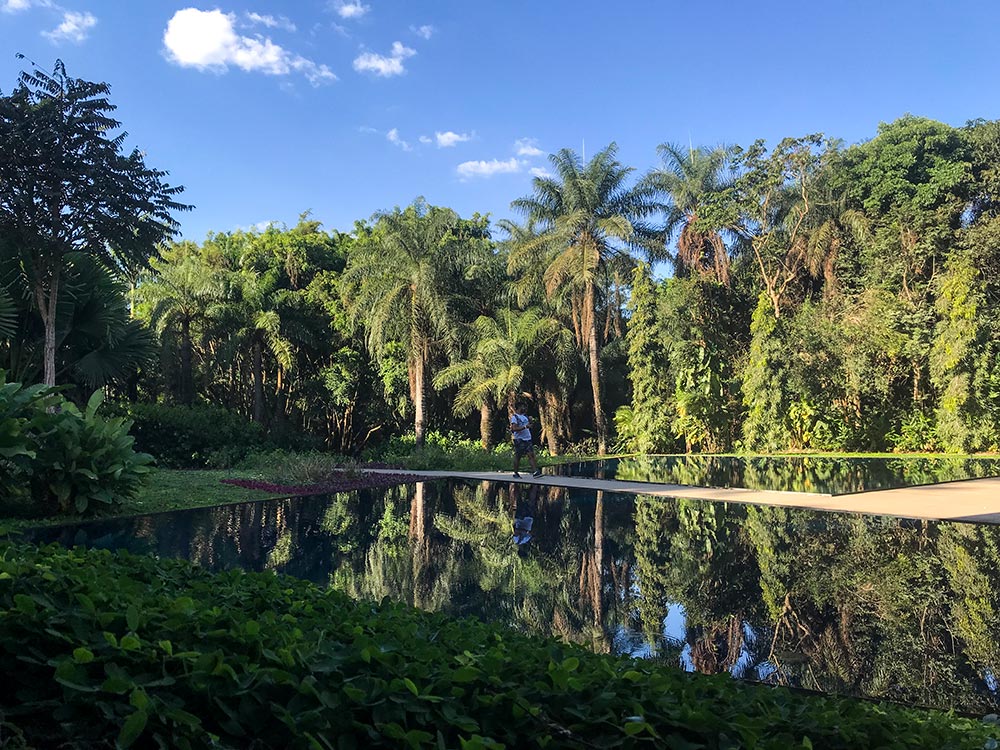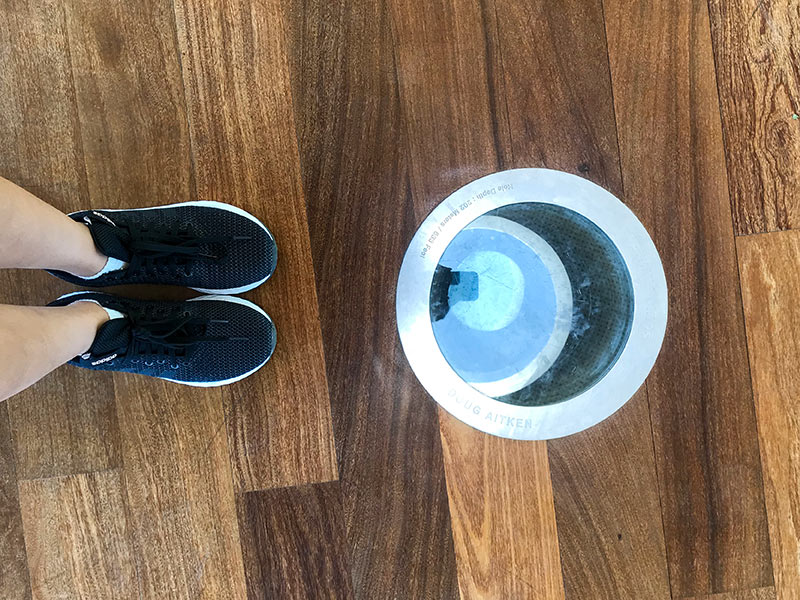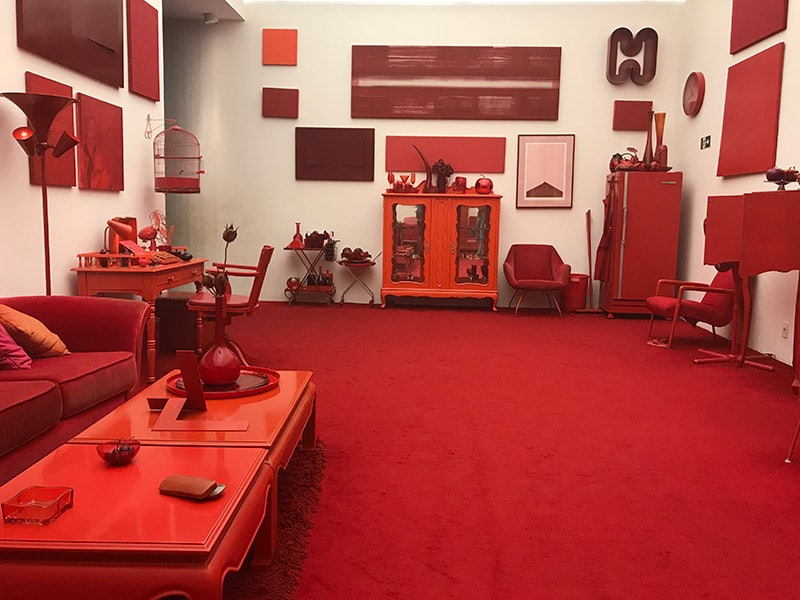Find out the best tips for visiting Inhotim, the biggest open-air museum of contemporary art of the world!
When I agreed to visit Belo Horizonte with other blogger friends (hi Foco no Mundo, O Baú do Viajante), I had no idea what I wanted to see in the city.
Matheus and I left the itinerary up to Débora, who has lived in the region all her life, and our only request was that one day be set aside to visit Inhotim. It is a kind of open-air contemporary art museum, where works of art are exhibited in pavilions, galleries and even in the open air as sculptures, with a total area of 750 hectares, but just under 100 of them are open to the public.
It is one of those walks where it seems that you are just walking through a gigantic park, until you accidentally bump into some art, lol.
I’ve already mentioned in other posts that museums are not really my thing, because I don’t understand the subject and in a short time I get very tired (too much information at once) and I can no longer distinguish the paintings and the authors. Inhotim, on the other hand, energized me from the first gallery we entered.
Besides the installations being very dynamic, many works are interactive and you need to participate to understand them. Unlike other museums, where you can just observe, at Inhotim you are in constant movement and feel (or so I felt) as if you were part of the works.
In the next paragraphs I will give you some tips to make the most of your visit and show you which were my favorite exhibits.
Tips for visiting Inhotim

When to visit
The Inhotim Institute is open from Wednesday to Sunday. The entrance fee is R$50, but on the first Wednesdays and last Sundays of the month the admission is free.
Although the galleries are closed, the rest of the park, as you might expect, is open air. If the forecast for your visit is rain, I suggest you reschedule.
How to get there
From Belo Horizonte there are two options to visit Inhotim: by car or by bus.
In the first case, you can take the BR-381 route towards Contagem, Betim and São Paulo, or the BR-040 towards Rio de Janeiro.
The bus route is run by the Saritur company, and the line to Inhotim departs from Tuesday to Sunday from Belo Horizonte’s bus station. The bus run twice a day, at 8:15 am, and at 4:30 pm (or 5:30 pm on weekends and holidays). The one way ticket costs R$38,70, while the return trip costs R$35.
If you are in a group, financially it is more worthwhile to rent a car. I suggest using Rentcars, a company that compares rates of the main car rental companies in the country. With it I could find daily rates of R$78 in the city, a little more than the price of a round trip for one person by bus.
Getting to know the park
The Inhotim Institute is home to numerous exhibits, and it is unlikely that you will be able to see all of them in just one day. My suggestion is to research in advance which ones interest you most, and set up a route around them.
The park is divided into the pink, yellow and orange routes. What my friends and I did was to start with the yellow route on foot, visiting some galleries such as the Praça and Cildo Meireles.
After visiting everything that interested us on this line, we switched to the pink one and went straight to the farthest exhibition, Doug Aitken’s Sonic Pavillion. We walked down towards the reception desk, and when we finished viewing the pink route, we stopped for lunch.
I think this is a great itinerary, because you start at the reception, arrive at the restaurant close to lunch time. That way, you also have the rest of the afternoon to explore the longest route, which is the orange one.
To get to know so many works in a short period of time, we purchased a day-use pass to the park’s internal transportation service, which costs R$30 per person. There are several predetermined paths where electric carts circulate taking you from one point to another.
Inhotim recommends doing the trip on foot, but I found the shuttle service indispensable and I would buy it again. Besides saving time, we took the opportunity to rest while waiting for the park’s vehicles.

Where to eat
Inhotim has two restaurants and a hamburger restaurant. The most famous one is Tamboril, with international cuisine and free buffet for R$79,00 per person. As we wanted to save money, we chose to have lunch at Oiticica, a self-service buffet where the price is R$49/kg. The food was excellent and there were many options of salads, pastas and meats.
The buffet restaurant is on the pink line, near the reception, and we designed our route so that we would be close to this restaurant around noon.
What to bring
The basics of any all day outdoor trip:
- Sunscreen
- Snacks
- Sunglasses
- Jacket
- Comfortable shoes
- Water
I also suggest bringing some snacks, such as cereal bars or chips, because the prices inside the park are exorbitant (the cheese bread was so expensive that I erased the value from my memory).
Exhibitions Not to Be Missed at Inhotim
Sonic Pavillion – Doug Aitken
The Sonic Pavilion houses a single work that took five years to complete. His goal was to drill a 200-meter deep hole in the earth, and then install microphones to listen to the sounds the planet emits.
To visitors, the site appears empty except for a small circular opening in the ground. Behind the scenes, however, there is an ultra-modern system that amplifies and equalizes the noises made by the earth, transmitting them in real time.
It is the furthest gallery in the park, and I consider it one of the most ambitious works there. It is marked on the map with the symbol G10, and it is on the pink line. The way there is long, so I recommend you use the internal transportation system.

Galeria Cildo Meireles
The two works we saw in the Cildo Meireles Gallery were Deviation to Red: Impregnation, Surrounding, Detour and Através. The concept of the first one was “a room where everything is red”.
I confess that when I heard this phrase the most my imagination could reach was red walls, but in fact the contrast is based on the opposite. Against a white background, the rest of the objects were full on red, which made the experience even more shocking.
Através is an installation that uses various types of materials, and where the floor is made of shards of glass. Both left me with an uncomfortable feeling, but intrigued at the same time. I guess that’s art, right?
It’s point G5 on the map and it’s on the yellow line, a short walk from the reception.

Cosmococa Gallery
Perhaps the most interactive of all the exhibits, the Cosmococa Gallery is composed of five “quasi-cinemas”, consisting of installations that use slide projections to give visitors multisensory experiences.
From what Deborah explained to us, the author’s idea was to simulate the effects people feel when they use drugs. I found the concept interesting, and I was surprised when I entered the first room, because it was full of pillows, and the goal was to jump on them and feel euphoric.
I won’t mention how the other rooms are because I think that surprise is part of getting to know the work, but I’ll say that even those who need a break can enjoy it.
The gallery is marked as G15 on the map, and is located on the orange line.
Viewing Machine – Olafur Eliasson
This artist is famous for recreating nature phenomena in an artificial way in his works, and this is what the “Viewing Machine” presents us with.
Based on the principle of the kaleidoscope, viewers are invited to handle the machine to obtain different types of reflections and shapes.
This was the only work that I said I was keen to see because it was the only one I had read about (I did not research in advance, such a great blogger). I confess that the physics part went a little unnoticed for me, but I loved seeing the reflection of my friends and even my own.
The project description says that the goal is to make visitors “realize themselves,” and I think this ends up happening in a really fun way.
It’s also on the orange line, and it’s the A13 on the map.
Tunga Psychoactive Gallery
I have to admit that I didn’t understand Tunga Psychoactive Gallery at all, but I think it’s a must-see anyway. The artist is one of the most famous in the national scene, but even looking in Wikipedia while I was in front of his work the concept escaped me.
This is gallery G21 on the map, but points A1 and G2 are also works by the same artist.
And there you have all the tips for visiting Inhotim and the must-see exhibits! If you have more time in the region, I recommend reading this post about what to do in Belo Horizonte!
What was your favorite exhibition? Tell me in the comments! 🙂
Exhibitions are constantly changing and being updated. Check the official website to find out what you can currently see in the museum!
